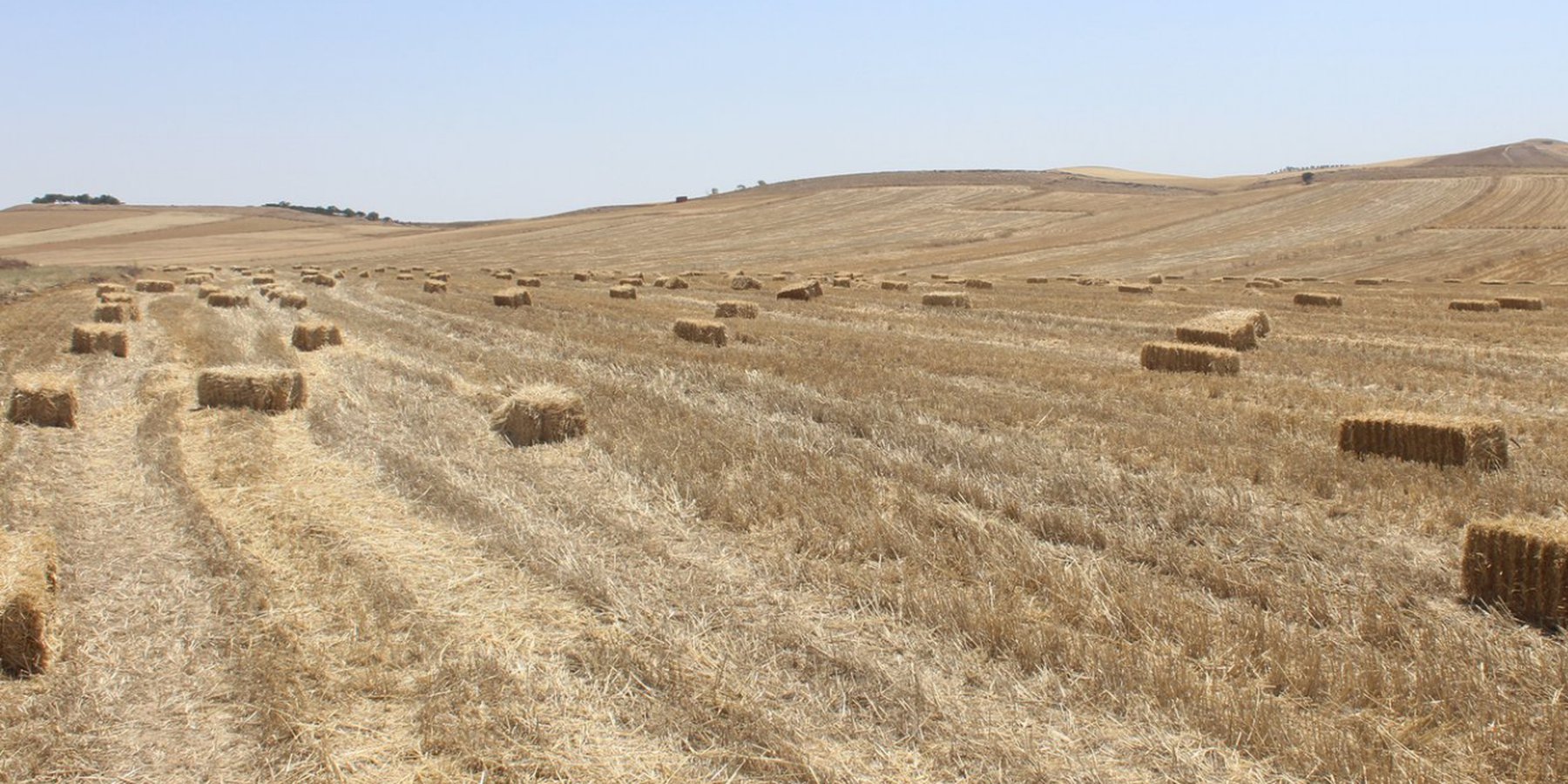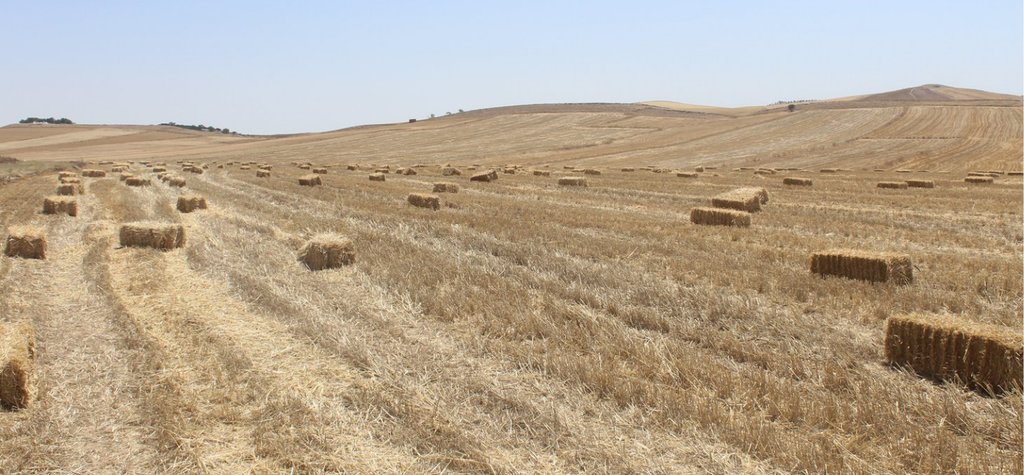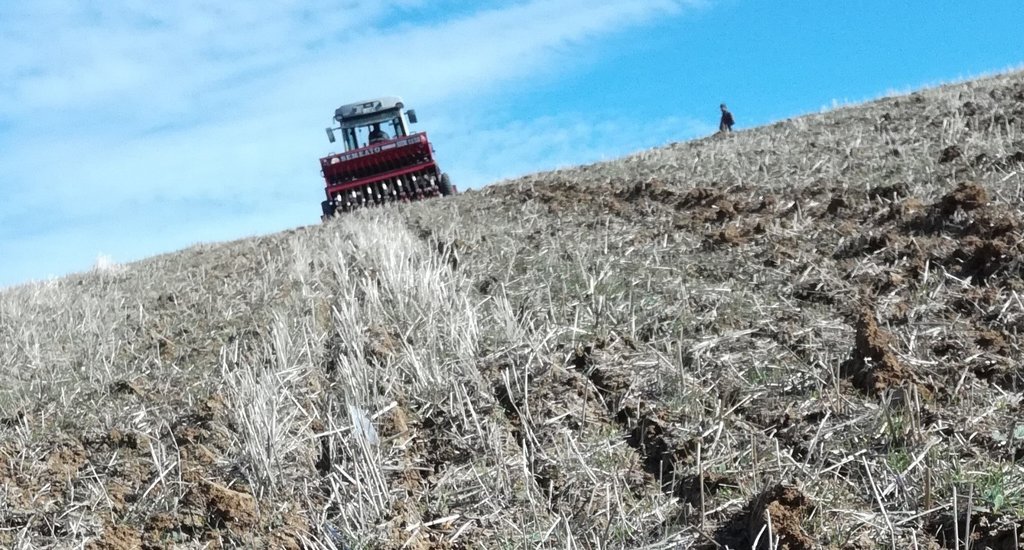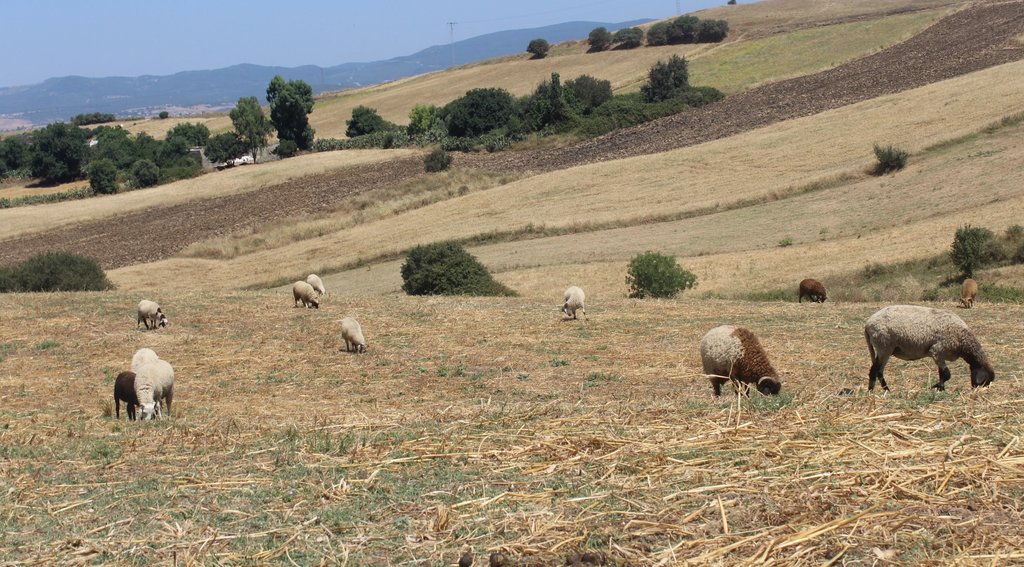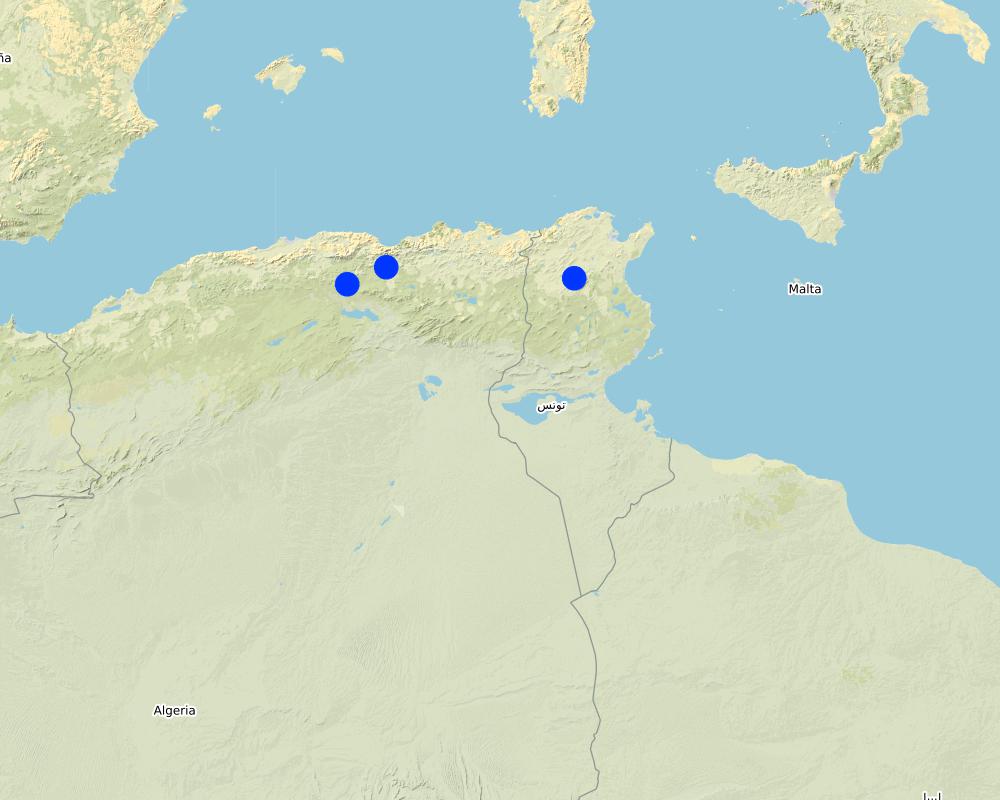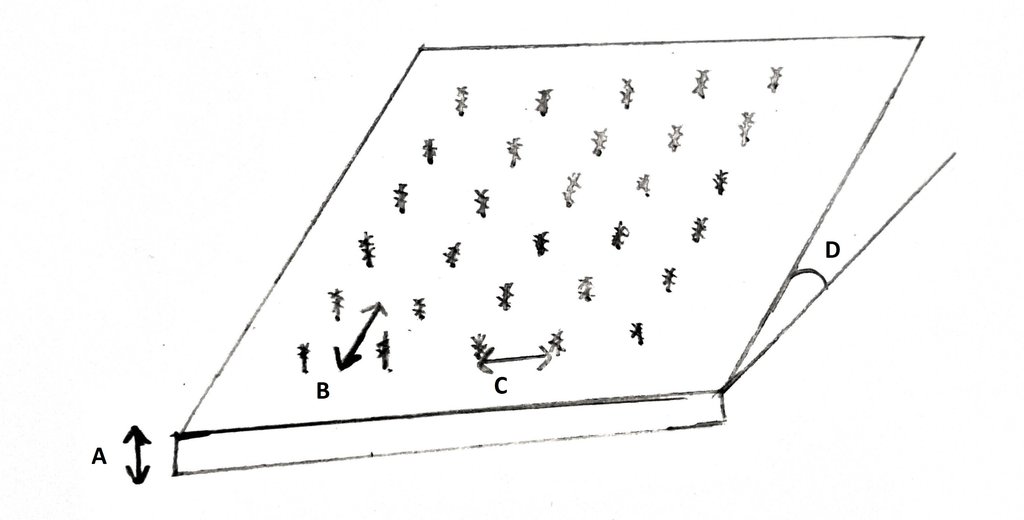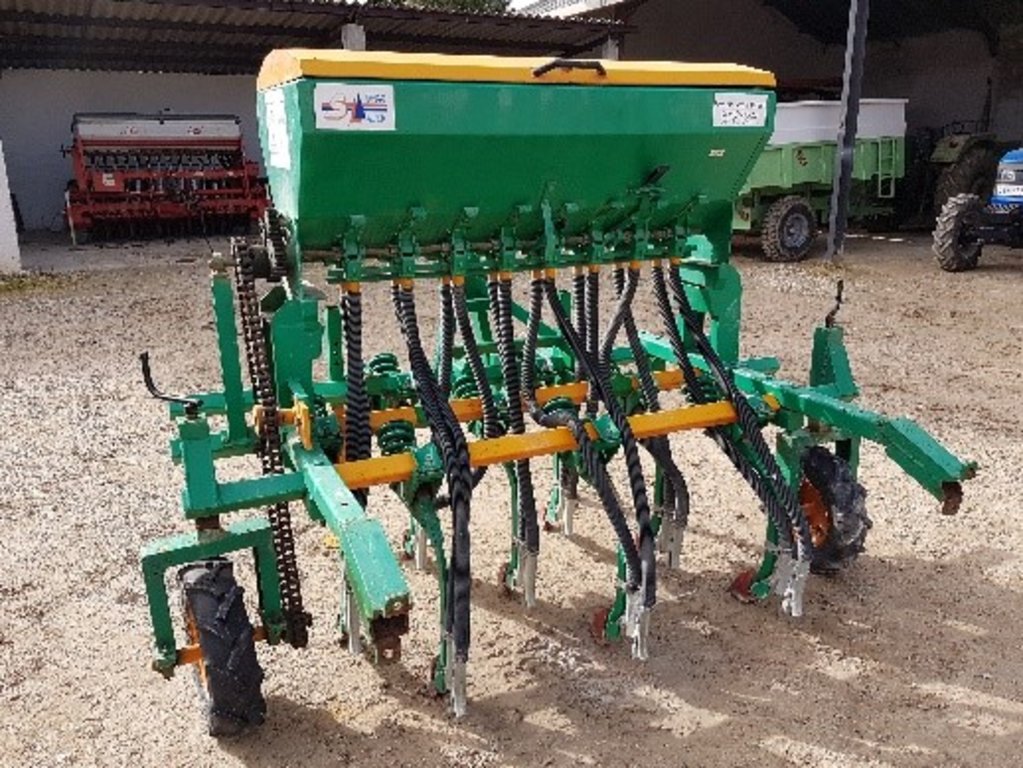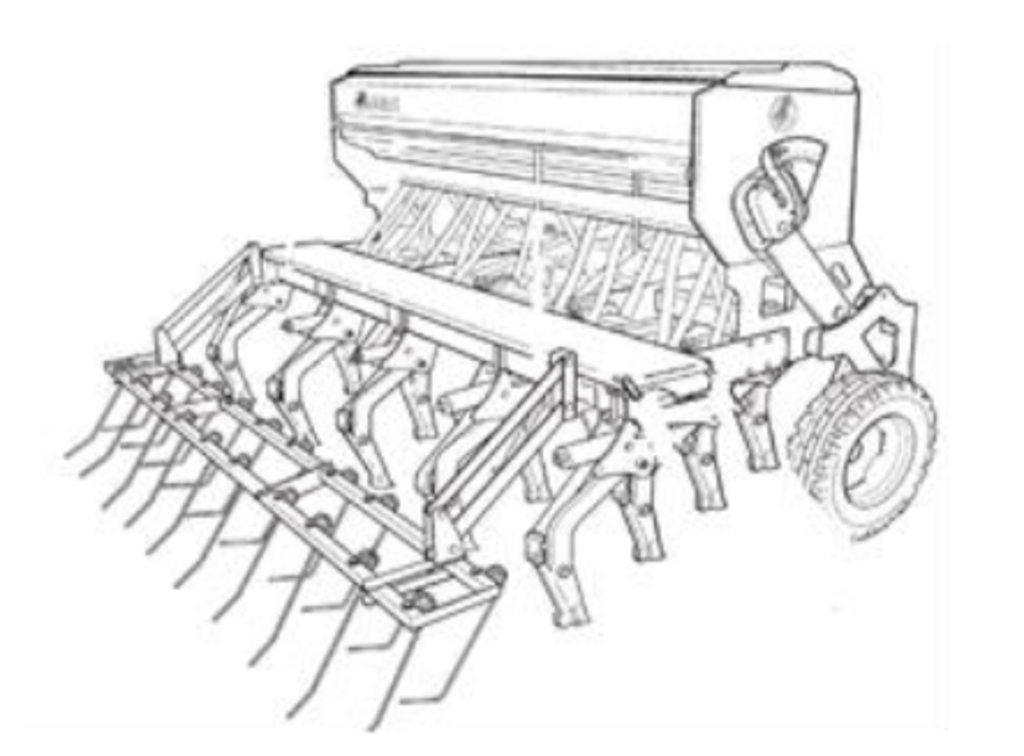Conservation Agriculture in Dryland Mixed Systems [تونس]
- تاريخ الإنشاء:
- تحديث:
- جامع المعلومات: Joren Verbist
- المحرر: –
- المُراجع: Rima Mekdaschi Studer
technologies_5819 - تونس
عرض الأقسام
توسيع الكل طي الكل1. معلومات عامة
1.2 تفاصيل الاتصال بالأشخاص الرئيسيين لمصدر المعلومات والمؤسسات المشاركة في تقييم وتوثيق التقنية
الشخص (الأشخاص) الرئيسي لمصدر المعلومات
Senior Livestock Scientist:
Rekik Mourad
International Center of Agriculture Research in the Dry Areas (ICARDA)
تونس
Agronomist:
M'hamed Cheikh Hatem
National Institute of Agricultural Research of Tunisia (INRAT)
تونس
Scaling Specialist:
Idoudi Zied
International Center of Agriculture Research in the Dry Areas (ICARDA)
تونس
اسم المشروع الذي سهّل توثيق/تقييم التقنية (إذا كان ذلك على صلة)
ICARDA Institutional Knowledge Management Initiativeاسم المؤسسة (المؤسسات) التي سهلت توثيق/تقييم التقنية (إذا كان ذلك على صلة)
International Center for Agricultural Research in the Dry Areas (ICARDA) - لبنان1.3 الشروط المتعلقة باستخدام البيانات الموثقة من خلال WOCAT
يوافق جامع المعلومات والشخص (لاشخاص) الرئيسي لمصدر المعلومات على الشروط المتعلقة باستخدام البيانات الموثقة من خلال WOCAT:
نعم
1.4 إعلان بشأن استدامة التقنية الموصوفة
هل التقنية الموصوفة هنا تمثل مشكلة فيما يتعلق بتدهور الأراضي، بحيث لا يمكن إعلانها تقنية مستدامة لإدارة الأراضي؟:
كلا
2. وصف تقنيةالإدارة المستدامي للأراضي
2.1 وصف مختصر للتقنية
تعريف التقنية:
Conservation Agriculture (CA) is a "ready-to-scale concept" in agriculture that allows a sustainable agricultural production and mitigation of climate change. The documented CA focuses on a dryland mixed system, including a biennial rotation of legume and cereals with integrated livestock management. CA has positive benefits on soil health and significantly reduces the needed inputs (e.g. fuel, labour) and workload for farmers.
2.2 وصف تفصيلي للتقنية
الوصف:
Land degradation leading to desertification is an increasingly important problem in the dry land regions of the globe. This does not only affect the bio-physical aspects such as carbon storage, but also the lives of local land users. Land degradation is often initiated by the lack of vegetation cover as is often a consequence of overgrazing and over-ploughing (i.e mismanagement). Furthermore, climate change leads to droughts, intensified rainfall events, increased temperature, and more extreme weather events. These compromised climatic conditions enhance land degradation. This leads to less fertile soils, reducing yields and consequently deteriorates the income and lives of local farmers. Taking the consequence and scale of degradation into account, natural resource conservation interventions are urgently required.
As the lack of soil cover is an, if not the, essential initiating factor in the desertification process, it should be maximally addressed. In the light of this, CA has been developed, based on three leading principles: i) minimizing soil disturbances or no-tillage, ii) maintaining a permanent soil cover with mulch, and iii) adequate crop rotations. Overall, the three principles prevent land degradation and can also rehabilitate the land. This is because soil organic matter is maintained in/on the soil and the erosive power of raindrops are broken by the soil cover. Therefore, CA aims for more sustainable resource use (land and water use) and to optimize climate-resilient and integrated crop-livestock systems to sustainably intensify production in fragile dry areas.
Tunisia is a country that experiences the previously described pattern and results of desertification and where smallholder farmers are largely dependent on livestock for income generation. However, the livestock competes with the concept of CA as plant residues (stubble) are normally grazed by the livestock. Conservation agriculture propagates no or minimum soil disturbance/ tillage. However, the purchase of a zero-tillage seeder machine appears to be a bottleneck due to high costs since they are hardly produced locally. Nevertheless, there are farmers in the semi -arid areas of Tunisia, who adopted the technology and experience significant benefits such as increased soil fertility and over time increasing yields. In addition, as erosion rates are high in this rainfed area of 300 to 600 mm annual precipitation, a well-covered soil will reduce runoff and loss of top soil. Since ploughing is restricted, the workload and the demanded fuel is reduced, resulting in decreased costs and labour with respect to the conventional practices. Furthermore, integrated crop-livestock is practiced by limiting livestock to graze only the freshly harvested fields while producing manure to enhance soil health (organic fertilization and increase in soil organic matter).
Additionally, according to the third principle of CA, legumes were introduced in the agricultural system (crop rotation), besides the conventional cereal (e.g. durum wheat or barley). Specifically, faba bean is promising, as it has nitrogen fixing effects, enhancing soil health, and increasing and diversifying farm income. Vetch and other forage mixtures have also been successfully introduced to provide farmers with nutritious feed for livestock within the CA concept. In irrigated areas (e.g. parts in Algeria), the practice of CA has an additional benefit as it increases the irrigation water use efficiency due to less evaporation and better infiltration.
The previous agro-pastoral farming practices changed under CA to an integrated crop-livestock system where soil cover is permanent. This mixed system consist of firstly weed control. Secondly, zero-tillage seeding is done directly into the soil even if covered with e.g. mulch/stubble. Faba bean and/or wheat are seeded and rotated yearly. This is beneficial as legumes fix nitrogen in the soil, lowering the amount of nitrogenous fertilizer needed. Thirdly, required fertilizers (for wheat additional nitrogenous fertilizer) is applied with a spreader. Fourthly, herbicides, pesticides, insecticides and fungicides are applied with a sprayer for disease control. Fifthly, the field is harvested with a combine. The stubble is then partly grazed by the sheep and goats until there remains a 1-2 cm residue layer i.e. mulch. For one hectare this accounts for a thirty day grazing period for thirty goats or sheep. This results in an integrated Crop-Livestock system under CA (CLCA), as the stubble provides feed for livestock while the livestock provides the soil with manure.
The land users that have adopted CA have indicated that they extremely appreciate the reduction in work, also the cost of labour and fuel, etc. In addition, they saw increased yields due to improved soil health. However, this beneficial impact could only be observed in the long-term since yields take time to increase, which can be considered as a weakness as the small holder farmer tends to prioritize short term profits. Another weakness is that the livestock is constrained since residues ought to remain on the field.
In conclusion, even though there are bottlenecks, the technology of conservation agriculture is a solution to combat desertification while improving the lives of local land users through the process.
Information and data presented is partly made available through the project “Use of conservation agriculture in crop-livestock systems (CLCA) in the drylands for enhanced water use efficiency, soil fertility and productivity in NEN and LAC countries” funded by the International Fund for Agricultural Development (IFAD), managed by the International Center for Agricultural Research in the Dry Areas (ICARDA) and implemented in Tunisia by the National Agricultural Research Institute (INRAT).
2.3 صور التقنية
2.5 البلد/المنطقة/المواقع التي تم تنفيذ التقنية فيها والتي يغطيها هذا التقييم
البلد:
تونس
المنطقة/الولاية/المحافظة:
Algeria: M'Sila and Setif; Tunisia: Siliana
حدد انتشار التقنية:
- منتشرة بالتساوي على مساحة
إذا كانت المساحة الدقيقة غير معروفة، فيرجى الإشارة إلى المنطقة التقريبية المغطاة:
- 1,000-100 كم2
هل يقع موقع/مواقع التقنية في منطقة محمية بشكل دائم؟:
كلا
التعليقات:
The land under CA in Tunisia and Algeria is 14 000ha and 5600 ha, respectively. Most of the sites (approximately 70%) are thus located in Tunisia. The regions pinned in the map represent the sites that match the documentation.
Map
×2.6 تاريخ التنفيذ
اذكر سنة التنفيذ:
1999
2.7 إدخال التقنية
حدد كيف تم إدخال التقنية:
- أثناء التجارب/الأبحاث
- من خلال المشاريع/ التدخلات الخارجية
3. تصنيف تقنية الإدارة المستدامي للأراضي
3.1 الغرض الرئيسي ( الأغراض الرئيسية) للتقنية
- تحسين الإنتاج
- الحد من تدهور الأراضي ومنعه وعكسه
- التكيف مع تغير المناخ/الظواهر المتطرفة وآثارها
- خلق أثر اقتصادي مفيد
3.2 نوع (أنواع) استخدام الأراضي الحالية حيث يتم تطبيق التقنية
استخدامات الأراضي مختلطة ضمن نفس وحدة الأرض:
نعم
حدد استخدام الأراضي المختلطة (المحاصيل / الرعي / الأشجار):
- الرعي الزراعي (بما في ذلك الإدارة المتكاملة للمحاصيل والثروة الحيوانية)

الأراضي الزراعية
- زراعة سنوية
الزراعة السنوية - حدد المحاصيل:
- الحبوب - قمح (شتوي)
- الحبوب البقولية والبقول- الفاصوليا
- Faba bean, vetch
نظام زراعة سنوي:
قمح أو دورة مماثلة مع القش/ زراعة المراعي
عدد مواسم الزراعة في السنة:
- 1
هل يتم ممارسة الزراعة البينية؟:
كلا
هل تتم ممارسة تناوب المحاصيل؟:
نعم
إذا كانت الإجابة بنعم، حدد:
Wheat is rotated with other crops (see technicality) such as faba bean or forage crops like vetch.

أراضي الرعي
الرعي المكثف/ إنتاج الأعلاف:
- قطع وحمل / صفر مرعى
- livestock allowed to graze only the freshly harvested fields
نوع الحيوان:
- الماعز
- الأغنام
هل يتم تطبيق الإدارة المتكاملة للمحاصيل والثروة الحيوانية؟:
نعم
إذا كانت الإجابة بنعم، حدد:
Crop residues remain on the field. This is allowed for limited grazing by the livestock after harvest (between april and july). The 30-30 rule states that is allowed for a 30 sized flock (sheep or goats) to graze 1 ha for 30 days. Logically, bigger flock means less days and vice versa. While the flock grazes the land it provides the soil with manure. Vetch is cut and carried to feed the livestock.
المنتجات والخدمات:
- اللحوم
- الحليب
الصنف:
الماعز
الصنف:
الأغنام
3.3 هل تغير استخدام الأراضي نتيجة لتنفيذ التقنية؟
هل تغير استخدام الأراضي نتيجة لتنفيذ التقنية؟:
- نعم (يرجى ملء الأسئلة أدناه فيما يتعلق باستخدام الأراضي قبل تنفيذ التقنية)
استخدامات الأراضي مختلطة ضمن نفس وحدة الأرض:
نعم
حدد استخدام الأراضي المختلطة (المحاصيل / الرعي / الأشجار):
- الرعي الزراعي (بما في ذلك الإدارة المتكاملة للمحاصيل والثروة الحيوانية)

الأراضي الزراعية
- زراعة سنوية
الزراعة السنوية - حدد المحاصيل:
- الحبوب - قمح (شتوي)
نظام زراعة سنوي:
زراعة مستديمة من القمح/الشعير/الشوفان/أرز الأراضي المرتفعة
هل يتم ممارسة الزراعة البينية؟:
كلا
هل تتم ممارسة تناوب المحاصيل؟:
كلا

أراضي الرعي
- livestock allowed to graze only the freshly harvested fields
نوع الحيوان:
- الماعز
- الأغنام
هل يتم تطبيق الإدارة المتكاملة للمحاصيل والثروة الحيوانية؟:
نعم
إذا كانت الإجابة بنعم، حدد:
livestock allowed to graze on the cereal stubbles left in the field.
المنتجات والخدمات:
- اللحوم
- الحليب
التعليقات:
The land use has not necessarily changed as in the previous agro-pastoral system, livestock was also allowed to graze the field, providing it with manure. The difference is that under CA the livestock is not allowed to fully graze the land, leaving a soil cover.
3.4 إمدادات المياه
إمدادات المياه للأرض التي يتم تنفيذ التقنية عليها:
- بعلية
3.5 مجموعةالإدارة المستدامة للأراضي التي تنتمي إليها هذه التقنية
- الإدارة المتكاملة للمحاصيل والثروة الحيوانية
- تحسين الغطاء الأرضي/النباتي
- الحد الأدنى من اختلال التربة
3.6 التدابير التقنية في مجال إلادارة المستدامة للأراضي

التدابير الزراعية
- A1: الغطاء النباتي/التربة
- A3: معالجة سطح التربة
- A6: إدارة المخلفات
A3: التمييز بين أنظمة الحراثة:
A 3.1: لا حرث
A6:حدد إدارة المخلفات:
A 6.4:تم الاحتفاظ بها

التدابير الإدارية
- M2: تغيير في مستوى الإدارة/الكثافة
التعليقات:
The residues are partly retained and partly grazed.
3.7 الأنواع الرئيسية من تدهور الأراضي التي تناولتها التقنية

تآكل التربة بالمياه
- الوزن(Wt): فقدان التربة السطحية/تآكل السطح
- (Wg):الانجراف الخلجاني/ الخلجان

تآكل التربة الناتج عن الرياح
- (Et): فقدان التربة السطحية

التدهور الكيميائي للتربة
- (Cn): تراجع الخصوبة وانخفاض محتوى المادة العضوية (غير ناتج عن الانجراف)

التدهور المادي أو الفيزيائي للتربة
- (Pk)ظهور وتكون قشرة سطحية

التدهور البيولوجي
- (Bc): تناقص الغطاء النباتي
- (Bq): انخفاض الكمية/الكتلة الحيوية
- (Bl): فقدان الحياة بالتربة
- (Bp): زيادة الآفات/الأمراض، وفقدان الحيوانات المفترسة

تدهور المياه
- (Ha): التجفيف
3.8 منع أو حد أو عكس تدهور الأراضي
تحديد هدف التقنية فيما يتعلق بتدهور الأراضي:
- منع تدهور الأراضي
- اصلاح/إعادة تأهيل الأراضي المتدهورة بشدة
التعليقات:
The technology of CA prevents land degradation as the soil cover prevents erosion because the cover breaks the erosive power of rainfall and wind. Also, CA has the ability to rehabilitate as the content (like organic matter and carbon) of the soil cover (e.g. mulch/stubble) remains in the soil eventually improving the soil quality.
4. المواصفات الفنية، وأنشطة التنفيذ، والمدخلات، والتكاليف
4.1 الرسم الفني للتقنية
المواصفات الفنية (المتعلقة بالرسم الفني):
The row interspace (C) for wheat and faba bean is respectively 17 centimeter and 35 centimeter. The density [plants per square meter] for wheat and faba bean is, respectively, 300-400 and 25. The spacing between crops in the row (B) for wheat and faba bean is, respectively, 1.5-2 centimeter and 11 centimeter. The slopes of the fields (D) vary between 3% and 10%.
For the livestock integration with CA, a flock of thirty (goats or sheep) may graze 1 hectare of stubble for a period of thirty days. This yields optimal trade-off between livestock and soil cover. As soil cover a 1-2 cm residue layer remains (A).
Please note that these values may vary with respect to different terrain, species of plants, flock size, and fertilizer application. For example if a flock contain more sheep or goats, it logically results in less grazing days.
المؤلف:
Joren Verbist
التاريخ:
22/12/2020
المواصفات الفنية (المتعلقة بالرسم الفني):
The local Tunisian zero-tillage seeder is named Sajir. This machine has better results than imported machines in terms of adjustable and homogeneous sowing depth, high germination rate and similar yield. The design is still changing to the recent and ongoing modifications (e.g. designing and manufacturing a local tine) to be better suitable to Tunisian soil context.
المؤلف:
Mohamed Jadlaoui
التاريخ:
01/01/2020
المواصفات الفنية (المتعلقة بالرسم الفني):
"Boudour" is a zero-tillage seeder machine used in Algeria.
Its technicality: The loading capacity is 150 kilogram of seeds and 150 kilograms for fertilizer.
The depth can be adjusted and is between 0 and 8 cm. The overall width is 2.8 meter whereas the seed row spacing is 18 centimetres.
The loading height is 154 centimetres.
It is suitable for a 65-76 horsepower tractor.
المؤلف:
SOLA
التاريخ:
01/04/2020
4.2 معلومات عامة بخصوص حساب المدخلات والتكاليف
حدد كيفية احتساب التكاليف والمدخلات:
- حسب مساحة تنفيذ التقنية
الإشارة إلى حجم ووحدة المساحة:
1 hectare
حدد العملة المستخدمة لحساب التكاليف:
- دولار أمريكي USD
اذكر متوسط تكلفة أجر العمالة المستأجرة في اليوم الواحد:
5.3
4.3 أنشطة التأسيس
| النشاط | التوقيت (الموسم) | |
|---|---|---|
| 1. | Purchase Zero-Tillage Seeder |
4.4 التكاليف والمدخلات اللازمة للتأسيس
| تحديد المدخلات | الوحدة | الكمية | التكاليف لكل وحدة | إجمالي التكاليف لكل مدخل | % من التكاليف التي يتحملها مستخدمو الأراضي | |
|---|---|---|---|---|---|---|
| معدات | Zero-Tillage Seeder | piece | 1,0 | 20000,0 | 20000,0 | |
| إجمالي تكاليف إنشاء التقنية | 20000,0 | |||||
| إجمالي تكاليف إنشاء التقنية بالدولار الأمريكي | 20000,0 | |||||
التعليقات:
The Zero-Tillage-Seeder can be bought as a community. This would lower the effective cost per farmer. Also, it is possible to hire Zero-Tillage Seeder.
4.5 الصيانة/الأنشطة المتكررة
| النشاط | التوقيت/الوتيرة | |
|---|---|---|
| 1. | Weeding (Total weed control) | Year 1 Early-October |
| 2. | Seeding Faba Bean | Year 1 Mid-October |
| 3. | Apply Baseline Fertilization | Year 1 Mid-October |
| 4. | Apply Herbicide | Year 1 Mid-October |
| 5. | Apply Fungicide and Insecticide | Year 1 March-Early April |
| 6. | Limited Grazing/Harvesting | Year 1 Late-April/May |
| 7. | Weeding (Total weed control) | Year 2 Early-November |
| 8. | Seeding Wheat | Year 2 Mid-November |
| 9. | Apply Baseline Fertilization | Year 2 Mid-November |
| 10. | Apply Nitrogenous Fertilization | Year 2 December-January-February |
| 11. | Apply Herbicide | Year 2 December |
| 12. | Apply Fungicide | Year 2 March-April |
| 13. | Limited Grazing/Harvesting | Year 2 Late-June/Early-July |
4.6 التكاليف والمدخلات اللازمة للصيانة/للأنشطة المتكررة (سنويًا)
| تحديد المدخلات | الوحدة | الكمية | التكاليف لكل وحدة | إجمالي التكاليف لكل مدخل | % من التكاليف التي يتحملها مستخدمو الأراضي | |
|---|---|---|---|---|---|---|
| العمالة | Weeding | Person-hour | 1,0 | 100,0 | ||
| العمالة | Seeding | Person-hour | 2,0 | 100,0 | ||
| العمالة | Fertilizer Application | Person-hour | 0,5 | 100,0 | ||
| العمالة | Harvesting | Person-hour | 2,0 | 100,0 | ||
| معدات | The Zero-Tillage Seeder (hiring cost) | Machine-hour | 2,0 | 16,5 | 33,0 | 100,0 |
| معدات | Sprayer (hiring cost for disease control) | Machine-hour | 4,5 | 11,0 | 49,5 | 100,0 |
| معدات | Spreader (hiring costs for nitrogenous fertilizer application) | Machine-hour | 1,5 | 11,0 | 16,5 | 100,0 |
| معدات | Combine (hiring cost for harvesting) | Machine-hour | 2,0 | 47,5 | 95,0 | 100,0 |
| المواد النباتية | Seeds Wheat | Kilogram | 160,0 | 0,4 | 64,0 | 100,0 |
| المواد النباتية | Seeds Faba Bean | Kilogram | 120,0 | 0,48 | 57,6 | 100,0 |
| الأسمدة والمبيدات الحيوية | Baseline Fertilization | Quintal | 2,5 | 19,9 | 49,75 | 100,0 |
| الأسمدة والمبيدات الحيوية | Nitrogenous Fertilization | Quintal | 3,0 | 15,5 | 46,5 | 100,0 |
| الأسمدة والمبيدات الحيوية | Pesticide (for total weed control) | Liter | 2,0 | 10,0 | 20,0 | 100,0 |
| الأسمدة والمبيدات الحيوية | Herbicide for grassy weeds | Liter | 1,0 | 41,2 | 41,2 | 100,0 |
| الأسمدة والمبيدات الحيوية | Herbicide for broadleaf weeds and sedges | Liter | 2,0 | 29,2 | 58,4 | 100,0 |
| الأسمدة والمبيدات الحيوية | Fungicide | Liter | 1,5 | 40,0 | 60,0 | 100,0 |
| الأسمدة والمبيدات الحيوية | Herbicide for annual and perennial grasses | Liter | 1,25 | 25,5 | 31,88 | 100,0 |
| الأسمدة والمبيدات الحيوية | Insecticide | Liter | 0,1 | 66,8 | 6,68 | 100,0 |
| غير ذلك | Casual Labour | Person-day | 12,0 | 5,3 | 63,6 | 100,0 |
| إجمالي تكاليف صيانة التقنية | 693,61 | |||||
| إجمالي تكاليف صيانة التقنية بالدولار الأمريكي | 693,61 | |||||
التعليقات:
Assuming a biennial rotation (Legume-Cereal), inputs and costs for the establishment of one hectare under the technology are displayed in the table. The costs for solely faba bean is 332.8 USD per hectare.
4.7 أهم العوامل المؤثرة على التكاليف
قدم وصفا لأهم العوامل التي تؤثر على التكاليف:
The initial purchase of the zero-tillage machine (20 000 USD) is dominantly affecting the costs of the technology. However, it should be taken into account, that this machine serves the long term. Because the area under description is dominated by small-scale farmers, access to zero-tillage machines is ensured through hiring private entrepreneurs or through the purchase of machines by farmers’ associations rather than individual farmers. Also, it is important to note that the additional costs of conservation agriculture mainly consists of the machine, the weeding control and the seeding of the legumes. Other costs are either similar or reduced with respect to conventional agriculture. For example, conventional agriculture requires three hours of ploughing and 1 hour of sowing. While conservation agriculture only needs half an hour for chemical weeding, 1 hour for sowing and does not require ploughing. This relates to reduced inputs such as fuel.
5. البيئة الطبيعية والبشرية
5.1 المناخ
هطول الأمطار السنوي
- < 250 مم
- 251- 500 ملم
- 501 - 750ملم
- 1,000-751 ملم
- 1,500-1,100 ملم
- 2,000-1,500 ملم
- 3,000-2,001 ملم
- 4,000-3,100 ملم
- > 4000 ملم
المنطقة المناخية الزراعية
- شبه قاحلة
- قاحلة
5.2 طوبوغرافيا
متوسط الانحدارات:
- مسطح (0-2%)
- بسيط (3-5%)
- معتدل (6-10%)
- متدحرج (11-15%)
- تلال (16-30%)
- شديدة الانحدار(31-60%)
- فائقة الانحدار (>60%)
التضاريس:
- هضاب/سهول
- أثلام مرتفعة
- المنحدرات الجبلية
- منحدرات التلال
- منحدرات في السفوح
- قاع الوادي
المنطقة الارتفاعية:
- 100-0 متر فوق سطح البحر
- 500-101 متر فوق سطح البحر
- 1,000-501 متر فوق سطح البحر
- 1,500-1,001 متر فوق سطح البحر
- 2,000-1,501 متر فوق سطح البحر
- 2,500-2,100 متر فوق سطح البحر
- 3,000-2,501 متر فوق سطح البحر
- 4,000-3,001 متر فوق سطح البحر
- > 4000 متر فوق سطح البحر
وضح ما إذا كانت التقنية مطبقة على وجه التحديد في:
- غير ذات صلة
5.3 التربة
متوسط عمق التربة:
- ضحل جدًا (0-20 سم)
- ضحلة (21-50 سم)
- متوسطة العمق (51-80 سم)
- عميقة (81-120 سم)
- عميقة جدًا (> 120 سم)
قوام التربة (التربة السطحية):
- متوسط ( طميي، سلتي)
قوام التربة (> 20 سم تحت السطح):
- خشن / خفيف (رملي)
- متوسط ( طميي، سلتي)
المواد العضوية في التربة السطحية:
- متوسطة (1-3%)
- منخفضة (<1%)
إذا كان متاحًا، قم بإرفاق وصف كامل للتربة أو تحديد المعلومات المتوفرة، على سبيل المثال نوع التربة، الرقم الهيدروجيني/ درجة حموضة التربة، قدرة التبادل الكاتيوني، النيتروجين، الملوحة وما إلى ذلك.
The top soil organic matter is relatively high as consequence of conservation agriculture.
5.4 توافر المياه ونوعيتها
منسوب المياه الجوفية:
< 5 م
توافر المياه السطحية:
ضعيف/ غير متوافر
نوعية المياه (غير المعالجة):
مياه الشرب سيئة (تتطلب معالجة)
تشير جودة المياه إلى:
المياه الجوفية
هل تعتبر ملوحة الماء مشكلة؟:
نعم
هل تحدث فيضانات في المنطقة؟:
كلا
5.5 التنوع البيولوجي
تنوع الأنواع:
- منخفض
تنوع الموائل:
- منخفض
5.6 خصائص مستخدمي الأراضي الذين يطبقون التقنية
مستقر أو مرتحل:
- غير المترحل
التوجه السوقي لنظام الإنتاج:
- مختلط (كفاف/ تجاري)
الدخل من خارج المزرعة:
- 10-50% من جميع الإيرادات
المستوى النسبي للثروة:
- ضعيف
- متوسط
أفراداً أو مجموعات:
- فرد/أسرة معيشية
- المجموعات/ المجتمع المحلي
مستوى المكننة:
- ميكانيكية/ مزودة بمحرك
الجنس:
- نساء
- رجال
عمر مستخدمي الأرضي:
- متوسط العمر
- كبار السن
5.7 متوسط مساحة الأرض التي يستخدمها مستخدمو الأراضي الذين يطبقون التقنية
- < 0.5 هكتارا
- 0.5 - 1 هكتار
- 1 -2 هكتار
- 2 - 5 هكتار
- 5 - 15 هكتار
- 15 - 50 هكتار
- 50 - 100هكتار
- 500-100 هكتار
- 1,000-500 هكتار
- 10,000-1,000 هكتار
- > 10,000 هكتار
هل يعتبر هذا نطاقًا صغيرًا أو متوسطًا أو واسعا (في إشارة إلى السياق المحلي)؟:
- على نطاق صغير
التعليقات:
Average size of smallholder farmers that have adopted CA have a farm size of less than ten hectares.
5.8 ملكية الأراضي، وحقوق استخدام الأراضي، وحقوق استخدام المياه
ملكية الارض:
- فردية، لا يوجد سند ملكية
- فردية، يوجد سند ملكية
حقوق استخدام الأراضي:
- فردي
حقوق استخدام المياه:
- مجتمعي (منظم)
- فردي
هل تعتمد حقوق استخدام الأراضي على نظام قانوني تقليدي؟:
نعم
حدد:
Land use rights in Tunisia have a long history with religious (e.g. melk) influences and French influences. This resulted in that currently most lands are private owned or state owned,
5.9 الوصول إلى الخدمات والبنية التحتية
الصحة:
- ضعيف
- معتدل
- جيد
التعليم:
- ضعيف
- معتدل
- جيد
المساعدة التقنية:
- ضعيف
- معتدل
- جيد
العمل (على سبيل المثال خارج المزرعة):
- ضعيف
- معتدل
- جيد
الأسواق:
- ضعيف
- معتدل
- جيد
الطاقة:
- ضعيف
- معتدل
- جيد
الطرق والنقل:
- ضعيف
- معتدل
- جيد
مياه الشرب وخدمات الصرف الصحي:
- ضعيف
- معتدل
- جيد
الخدمات المالية:
- ضعيف
- معتدل
- جيد
6. الآثار والتصريحات الختامية
6.1 الآثار التي أظهرتها التقنية في الموقع
الآثار الاجتماعية والاقتصادية
الإنتاج
إنتاج المحاصيل
التعليقات/ حدد:
Over time the crop production increases as the soil quality increases
جودة المحاصيل
التعليقات/ حدد:
Over time the crop quality increases as the soil quality increases
إنتاج الأعلاف
جودة العلف
الدخل والتكاليف
النفقات على المدخلات الزراعية
التعليقات/ حدد:
Less fuel needen for ploughing. This was a signficant cost in the conventional system.
دخل المزرعة
التعليقات/ حدد:
The farm income increases as there are less costs and higher yields with respect to the previous agricultural acitivites.
عبء العمل
التعليقات/ حدد:
Farmers spend less work on the field as the field is not ploughed.
الآثار الاجتماعية والثقافية
المعرفة بالإدارة المستدامة للأراضي/تدهور الأراضي
الآثار الايكولوجية
دورة المياه / الجريان السطحي
حصاد / جمع المياه
التعليقات/ حدد:
Less water runs off due to soil cover. Thus more water is collected in the soil.
الجريان السطحي
التعليقات/ حدد:
Due to the soil cover, more water is retained and less water runs-off.
التبخر
التعليقات/ حدد:
The soil cover provides shade for the soil. Therefore less water is evaporated.
التربة
رطوبة التربة
التعليقات/ حدد:
The soil is more moist as the soil cover provides shade. So the soil has a lower temperature.
غطاء التربة
التعليقات/ حدد:
CA strives for permanent soil cover.
فقدان التربة
التعليقات/ حدد:
The soil cover breaks the erosive power of rain drops. Also due to decreased run-off, there is less erosion.
تراكم التربة
التعليقات/ حدد:
The soil cover eventually decomposes into the soil which lead to accumulation.
تكون قشرة التربة السطحية/انسداد مسام التربة
التعليقات/ حدد:
The splash erosion of the rain drops is broken by the soil cover, resulting in less crusting.
دورة المغذيات/إعادة الشحن
المادة العضوية في التربة/تحت الطبقة c
التعليقات/ حدد:
The soil cover is decomposed in the soil. Which is partly carbon.
التنوع البيولوجي: الغطاء النباتي، الحيوانات
الكتلة الحيوية/ طبقة الكربون فوق التربة
التنوع النباتي
التعليقات/ حدد:
CA encourages the use of adequate crop rotation.
الأنواع المفيدة
التعليقات/ حدد:
CA encourage the use of beneficial species like legumes that fixate nitrogen.
الحد من مخاطر المناخ والكوارث
المناخ الموضعي (مايكرو)
6.2 الآثار التي أظهرتها التقنية خارج الموقع
تراكم الطمي باتجاه مصب النهر
التعليقات/ حدد:
As conservation agriculture reduces erosion, it consequently reduces downstream siltation.
الرواسب المنقولة بواسطة الرياح
6.3 تعرض التقنية وحساسيتها لتغير المناخ التدريجي والظواهر المتطرفة/الكوارث المرتبطة بالمناخ (كما يراها مستخدمو الأراضي)
تغير مناخ تدريجي
تغير مناخ تدريجي
| الموسم | زيادة أو نقصان | كيف تتعامل التقنية مع ذلك؟ | |
|---|---|---|---|
| درجة الحرارة السنوية | زيادة | جيدا | |
| هطول الأمطار السنوي | انخفاض | جيدا |
الظواهر المتطرفة / الكوارث المرتبطة بالمناخ
الكوارث المناخية
| كيف تتعامل التقنية مع ذلك؟ | |
|---|---|
| حريق الأرض | ليس جيدا |
الكوارث البيولوجية
| كيف تتعامل التقنية مع ذلك؟ | |
|---|---|
| أمراض وبائية | ليس جيدا |
6.4 تحليل التكلفة والعائد
كيف يمكن مقارنة العوائد نسبة لتكاليف الإنشاء (من وجهة نظر مستخدمي الأراضي)؟
عوائد قصيرة الأجل:
سلبي
عوائد طويلة الأجل:
إيجابي قليلا
كيف تتم مقارنة العوائدمع كلفة الصيانة/التكاليف المتكررة (من وجهة نظر مستخدمي الأراضي)؟
عوائد قصيرة الأجل:
إيجابي
عوائد طويلة الأجل:
ايجابي جدا
التعليقات:
The maintenance of conservation agriculture is positively experienced because of the reduced workload and inputs as the additional costs of e.g. weeding and pest control are not larger than the original costs of weeding and ploughing. However, the establishment costs are considered negative due to the significant costs of the zero-tillage machine. In the long term, the improved soil conditions should have maximum benefits.
6.5 اعتماد التقنية
- 1-10%
من بين جميع الذين تبنوا التقنية، كم عدد الذين فعلوا ذلك بشكل تلقائي، أي دون تلقي أي حوافز مادية/مدفوعات؟:
- 11-50%
6.6 التكيف
هل تم تعديل التقنية مؤخرًا لتتكيف مع الظروف المتغيرة؟:
نعم
أخرى (حدد):
The demand of the farmers
حدد تكيف التقنية(التصميم، المواد/الأنواع، الخ.):
The farmers demanded different dimensions for the Zero-Tillage-seeder, related to their desired inter rows spaces e.g. a wider seeder so more area is seeded in the same time.
6.7 نقاط القوة / المزايا / الفرص التي توفرها التقنية
| نقاط القوة/ المزايا/ الفرص من وجهة نظر مستخدمي الأراضي |
|---|
| Conservation Agriculture (CA) reduces the costs and workload with respects to conventional farming. For example, in conventional agriculture the field was ploughed, which costed machine hours. This cost is cancelled out by conservation agriculture, following the three principles. On top of that, this results in less costs such as depreciation of the plough and less consumed fuel. |
| CA leads to improved soil conditions and reduced/prevented land degradation which leads to increased biomass-production. This does benefit the land user. However, these benefits are noticeable in the long term. So, conservation agriculture is therefore significantly beneficial and (economically) important for family farms, where the land is passed on to future generations. |
| In irrigated areas, conservation agriculture leads to improved irrigation water use efficiency because of less water evaporation from the soil surface. Additionally, in flood irrigated areas, the soil is better protected and not flushed away. Farmers that have limited amount of irrigation water consider this a great benefit. In Algeria for example, the impact of CA practices resulted in a 30–40% reduction in the use of irrigation water and a two- to three-fold increase in barley and wheat production without the use of better seeds. |
| نقاط القوة/ المزايا/ الفرص من وجهة نظر جامع المعلومات أو غيره من الاشخاص الرئيسيين لمصدر المعلومات |
|---|
| In Tunisia, it has been proven that CA based on Zero tillage and soil residue retention vs conventional agriculture contributes to make wheat production more resilient to climate change through enhancing wheat yield (15%), improvement of water use efficiency (13% to 18%), increase organic carbon accumulation (0.13 ton/ha/year to 0.18 ton/ha/year-). The reduction of soil loss caused by soil water erosion varies between 1.7 ton/ha/year to 4.6 ton/ha/year of soil loss. |
| CA prevents desertification. This is important as the desertification is increasing in dry lands. Thereby, it reduces the socio-economic capacity of the rural population, because of deteriorated biomass-production. Hence conservation agriculture is important to develop capacity in the rural areas of the dry lands as it ensures increased yields (i.e. higher income) |
| Soil microbial activity is an indicator for soil fertility. Preliminary results showed that soil microbial activity was higher under CA than conventional practices for different studied soil layers (0-15 cm, 15-25 cm and 25-45 cm). |
| Regarding the impact of CA on natural resources, especially soil health and water efficiency. Scientific evidences show that soil loss due to erosion reduced by 14 percent, some 62 kilograms per hectare under CA practices compared to conventional practices. |
6.8 نقاط ضعف / مساوىء / مخاطر التقنية وسبل التغلب عليها
| نقاط الضعف/ المساوىء/ المخاطر من وجهة نظر مستخدم الأراضي | كيف يمكن التغلب عليها؟ |
|---|---|
| The competition between livestock is identified as a major issue in terms of effectiveness and adoptability of conservation agriculture (CA). Livestock grazes the stubble and crop residues, reducing the amount of soil cover on the field, thus lowering the protection and improvement of the soil. And as most farmers rely on livestock, this conflict between livestock and CA lowers the adoption rate of the technology. | This can be addressed through integrated smart livestock management. The approach should aim at minimizing the harm to soil cover, while maximizing the nutrition intake of livestock. The 30/30-model, in which the optimal trade-off between soil cover and grazing period is found, offers such solution. Here 30 sheep or goats may graze one hectare for thirty days. This leaves enough soil cover and meets livestock demand. |
| The price and availability of the zero-tillage seeder is crucial in the farmer's decision to adopt CA. The purchase of such a machine is namely very high for a farmer. It is unlikely that a farmer is willing to invest this huge amount as the farmer prefers profit in the short term. | Investments (private and government) are needed to boost the manufacturing of national made zero-tillage seeder. This would increase the availability of the machine and decrease the price. Furthermore, farmers may organize themselves into communitiy user groups and cooperations hence, lowering the cost per farmer. However, good governance and planning of machine use is essential, as tension may develop during the short sowing period for the use of the machine. |
| The risks of pests and weeds increase during first years of the transition from conventional tillage to CA because of the residues left on the field and the change in the weeds flora. These form a good basis for disease development. | In the short term this can be overcome by using herbicides and fungicides. However, this might be paired with other risks. Therefore, there should be research into alternative pest controls measures, such as intercropping or the introduction of natural enemies. |
| نقاط الضعف/ المساوىء/ المخاطر من وجهة نظر جامع المعلومات أو غيره من الاشخاص الرئيسيين لمصدر المعلومات | كيف يمكن التغلب عليها؟ |
|---|---|
| The low capacity of farmers to invest in CA, specifically a zero-tillage seeder, is a weakness. This is due to the lack of government support and due to the small scale of most farms (80% of the Tunisian farmers have less than 10 ha of land). |
Iimprove institutional support by for example the government. The government can support farmers by giving subsides to allow the purchase of a zero-tillage seeder machine. The wider scale adoption of CA requires a change in commitment and behavior of all stakeholders. Such changes call for sustained policy and institutional support that provides both incentives and motivations to encourage farmers to adopt components of CA practices and improve them over time. |
| The increasing use of pesticides for weeding and pest control is a growing concern and risk. Pesticides may have harming effects on the soil, the biodiversity and the public health. | Alternatives to pesticides can overcome this risk. However, research is needed to scrutinize this and if it is cost-effective. Possible alternative approaches are intercropping and the introduction of natural enemies. This would not only mitigate the risk of pests and weeding, but also enhance soil health and biodiversity. |
7. المراجع والروابط
7.1 طرق جمع/مصادر المعلومات
- مقابلات مع المتخصصين/الخبراء في الإدارة المستدامة للأراضي
- التجميع من التقارير والوثائق الأخرى الموجودة
7.2 المراجع للمنشورات المتاحة
العنوان، المؤلف، السنة، النظام القياسي الدولي لترقيم الكتب ISBN:
Amir Souissi, Bahri Haithem, Hatem Cheikh M'hamed, Mohamed Chakroun, Salah Ben Youssef, Aymen Frija, Mohamed Annabi. (7/8/2020). Effect of Tillage, Previous Crop, and N Fertilization on Agronomic and Economic Performances of Durum Wheat (Triticum durum Desf. ) under Rainfed Semi-Arid Environment. Agronomy, 10(8).
متاح من أين؟كم التكلفة؟:
https://hdl.handle.net/20.500.11766/11886
العنوان، المؤلف، السنة، النظام القياسي الدولي لترقيم الكتب ISBN:
Amar Rouabhi, Abdelmalek Laouar, Abdelhamid Mekhlouf, Boubaker Dhehibi. (1/3/2019). Socioeconomic assessment of no-till in wheat cropping system: a case study in Algeria. New Medit, 18(1).
متاح من أين؟كم التكلفة؟:
https://hdl.handle.net/20.500.11766/9761
العنوان، المؤلف، السنة، النظام القياسي الدولي لترقيم الكتب ISBN:
Bahri Haithem, Mohamed Annabi, Hatem Cheikh M'hamed, Aymen Frija. (1/11/2019). Assessing the long-term impact of conservation agriculture on wheat-based systems in Tunisia using APSIM simulations under a climate change context. Science of the Total Environment, 692, pp. 1223-1233.
متاح من أين؟كم التكلفة؟:
https://hdl.handle.net/20.500.11766/10157
العنوان، المؤلف، السنة، النظام القياسي الدولي لترقيم الكتب ISBN:
CLCA Project Page
متاح من أين؟كم التكلفة؟:
https://mel.cgiar.org/projects/clca2
7.3 روابط للمعلومات ذات الصلة على الإنترنت
العنوان/الوصف:
Zied Idoudi, Nasreddine Louahdi, Mina Devkota Wasti, Zahra Djender, Aymen Frija, Mourad Rekik. (26/4/2020). Public-Private Partnership for enhanced conservation agriculture practices: the case of Boudour Zero-Till seeder in Algeria. Lebanon: International Center for Agricultural Research in the Dry Areas (ICARDA).
عنوان الرابط URL:
https://hdl.handle.net/20.500.11766/11047
العنوان/الوصف:
Mourad Rekik, Santiago López Ridaura, Hatem Cheikh M'hamed, Zahra Djender, Boubaker Dhehibi, Aymen Frija, Mina Devkota Wasti, Udo Rudiger, Enrico Bonaiuti, Dina Najjar, Zied Idoudi. (26/11/2019). Use of Conservation Agriculture in Crop-Livestock Systems (CLCA) in the Drylands for Enhanced Water Use Efficiency, Soil Fertility and Productivity in NEN and LAC Countries – Project Progress Report: Year I - April 2018 to March 2019. Jordan: International Center for Agricultural Research in the Dry Areas (ICARDA).
عنوان الرابط URL:
https://hdl.handle.net/20.500.11766/10444
العنوان/الوصف:
Udo Rudiger, Hatem Cheikh M'hamed. (1/5/2019). Inspired by Nature - A Tunisian Farmer’s Perspective on Sustainable Integration of Crop and Livestock. (Short version).
عنوان الرابط URL:
https://hdl.handle.net/20.500.11766/10013
العنوان/الوصف:
Peter Fredenburg, Colin Piggin, Michael Devlin. (30/11/2012). Conservation agriculture: opportunities for intensified farming and environmental conservation in dry areas. Aleppo, Syria: International Center for Agricultural Research in the Dry Areas (ICARDA).
عنوان الرابط URL:
https://hdl.handle.net/20.500.11766/5073
العنوان/الوصف:
Hichem Ben Salem. (15/12/2015). Strategic Practical Options for Integrating Conservation Agriculture Cropping and Livestock Systems. Amman, Jordan: International Center for Agricultural Research in the Dry Areas (ICARDA).
عنوان الرابط URL:
https://hdl.handle.net/20.500.11766/4999
العنوان/الوصف:
Hichem Ben Salem. (4/5/2016). Recent trends in conservation agriculture.
عنوان الرابط URL:
https://hdl.handle.net/20.500.11766/4771
العنوان/الوصف:
Aymen Frija. (26/11/2016). Conservation Agriculture: strengthening crop production in marginal areas. URL: https://globalfutures.cgiar.org/2016/11/28/conservation-agriculture-strengthening-crop-production-in-marginal-areas/
عنوان الرابط URL:
https://hdl.handle.net/20.500.11766/6120
العنوان/الوصف:
Hajer Guesmi, Hichem Ben Salem, Nizar Moujahed. (1/9/2019). Integration crop-livestock under conservation agriculture system. Journal of New Science, 65(1), pp. 4061-4065.
عنوان الرابط URL:
https://hdl.handle.net/20.500.11766/11423
العنوان/الوصف:
Bahri Haithem, Mohamed Annabi, Hatem Cheikh M'hamed, Aymen Frija. (1/11/2019). Assessing the long-term impact of conservation agriculture on wheat-based systems in Tunisia using APSIM simulations under a climate change context. Science of the Total Environment, 692, pp. 1223-1233.
عنوان الرابط URL:
https://hdl.handle.net/20.500.11766/10157
العنوان/الوصف:
Ayoub Fouzai, Maroua Smaoui, Aymen Frija, Boubaker Dhehibi. (5/5/2019). Adoption of Conservation Agriculture Technologies by Smallholder Farmers in the semiarid region of Tunisia: Resource constraints and partial adoption. Journal of New Sciences, 6(1), pp. 105-114.
عنوان الرابط URL:
https://hdl.handle.net/20.500.11766/9988
الروابط والوحدات المواضيعية
توسيع الكل طي الكلالروابط
لا يوجد روابط
الوحدات المواضيعية
لا يوجد وحدات مواضيعية


